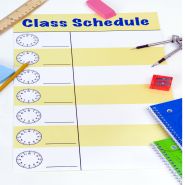Managing behaviour is a challenge faced by teachers young and old. You are unlikely to hear of a teacher who believes they have complete control of the classroom at all times. But this is where behaviour lessons can help.
Teachers spend a large amount of their time managing behaviour. The end of the academic year is a time where school staff can reflect on the year that has passed and what the new one will bring.
The end of the year is time for reflection on behaviour management techniques as well as the overall quality of lessons. But how can behaviour lessons contribute to improved behaviour? This blog post explains.
Top tips for improving behaviour
Step 1: Take action before the lesson begins
When students arrive at the classroom make sure that they are greeted with positivity. A welcome and a smile will go a long way.
Step 2: Become the broken record
If you establish clear boundaries and expectations with your classes early on it will establish the chances of behaviour escalating.
Work together with the students to form class rules or a charter and you may be surprised by how high the student expectations of behaviour are. Children work better when they know what to expect and where they stand.
Low level behaviour standards may include:
- Talking when teacher/others are talking
- Fiddling with equipment (e.g. pen tapping)
- Heads on desks
- Not looking at the teacher when they are talking
- Carrying on with work when told to stop
- Hands in pockets
- Sitting back on two legs of the chair
- Turning around to talk to others
Step 3: Power of pausing
Unrelenting reminders about low level disruption will have limited effect – and teachers should consider these with a tactical pause.
To achieve the results, stop whatever you are saying or doing and silence will become apparent in the classroom.
Usually the young person displaying the low-level disruption or holding up the lesson will get the message and stop whatever they are doing. Failing this a faint whisper from a fellow student who has the message works equally well.
Step 4: Don’t say ‘Please’
This rule makes you show expectation and obligation.
According to Paul Dix: “Thank you has a marked effect on how the request is received”.
Making a comment such as “I need you to put your ruler away, thank you”, implies that you know they will follow instructions and are thanking them in advance. This is a subtle rule which has proved itself to be an effective time saver.
Step 5: Try not to be ‘cool’
It is important not trying to befriend the students or become the ‘cool teacher’. Positive teacher-student relationships can be formed over time through sincerity and trust.
As adults we are aware of people who try to form instant (often superficial) relationships – in the same way, you should allow positive relationships with your students to form over time.
Step 6: Delegate responsibility
By delegating responsibility for behaviour – instead of directly telling students off for wrongdoing – is a more positive way to influence behaviour.
With behaviour in the student’s own hands, a difficult lesson or unstructured activity presents the students with an opportunity to reflect on their behaviour and take responsibility. As a teacher you can give the class time to discuss what needs doing to make things right and how to stop something from happening again. Collectively you can decide if others in the class can help.
You can ask students what they would do in the teacher’s position. This is where they can own not only their behaviour but also the consequence.
Step 7: Speak to the family
According to Teacher Toolkit:
In order to foster and maintain relationships with the students calling home on a regular basis to discuss how our students are doing is vital.
It means there is a collective standard setting from parents, schools and the pupils themselves. Sending positive cards home when a pupil has done something above and beyond can help engage the whole family and help all parties work together.
Parents who are difficult to reach are usually the ones that communication will have the most positive impact on. But to reach them you may need a home visit – and you may want a colleague to attend with you if you are unsure how the visit will go.
Step 8: You own the classroom
By walking round and being confident you can have profound effect on the student. Be unpredictable and curious. Be a positive role model in how to speak to students and other staff.
Finally – apologise if you make a mistake. You are modelling this for the child or young person and this will support you to built trust and respect.
Step 9: The importance of routines
Set your classroom habits with crystal clear expectations and don’t deviate from them. You will soon see the benefits of the children knowing what to expect and where they stand. Invest time in setting up your routines and planning for behaviour.
You should talk about routines and expectations regularly, the start of a new term is a good time for this.
Step 10: Praise your pupils
The classroom is a place filled with funny and positive interactions, and your students will all feel appreciated in different ways.
Paul Dix uses the analogy: “I can give you a special and make you feel like a king. I can give you £50 and make you feel like you don’t matter.”
By paying attention to your students, noticing their positive behaviours and make subtle praise. You can allow students to identify the types of praise and rewards that they appreciate and only give praise when it is earned.”
How EDClass can help with improving behaviour
At EDClass we are here to help students reduce and eradicate low level disruptive behaviour.
We have created a number of behaviour lessons and behavioural repair work sessions for your students to follow when they have behaved inappropriately.
The behaviour lessons on EDClass have been assembled so that they address Ofsted’s requirements for behaviour work. The modules include:
Bullying Modules: Physical bullying; homophobic bullying; racist bullying
Verbal Abuse Against a Pupil Modules: Threatened violence; aggressive behaviour; swearing; homophobic abuse and harassment; verbal intimidation; carrying an offensive weapon
Physical Assault Against a Pupil Modules: Fighting; violent behaviour; wounding; obstruction and jostling
Persistent Disruptive Behaviour: Challenging behaviour; disobedience; persistent violation of school rules
Sexual Misconduct: Sexual assault; sexual abuse; sexual harassment; lewd behaviour; sexual bullying; sexual graffiti
Damage: Vandalism; arson; graffiti
Physical Assault Against an Adult: Violent behaviour; wounding; obstruction and jostling
Racist Abuse: Racist taunting and harassment; derogatory racist statements; swearing that can be attributed to racist characteristics; racist bullying; racist graffiti
Theft: Stealing school property; stealing personal property (from a pupil or adult); stealing from local shops on a school outing; selling and dealing in stolen property
Drug and Alcohol Related Abuse: Alcohol abuse; inappropriate use of prescribed drugs; possession of illegal drugs; drug dealing; smoking; substance abuse
Verbal Abuse Against an Adult: Threatened violence; swearing; homophobic abuse and harassment; verbal intimidation; carrying an offensive weapon
All lessons have scenarios, tasks and questions to challenge the student’s learning and understanding of the severity of each behaviour.
For more advice on managing behaviour in schools click here.
For more information call 01909 568 338.









